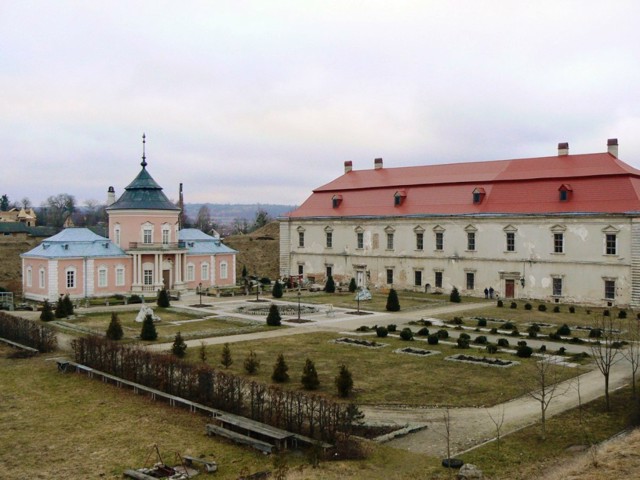Functional temporarily unavailable
General information about Zolochiv
The city of Zolochiv is a regional center on the Lviv-Ternopil highway, which is part of the "Golden Horseshoe" of the Lviv region. The first fortification of Radeche on the Kupina hill above the river. Zolochivka appeared in the XIII century. The first written mention of Zolochev dates back to 1427, when the proud passed from the Kerdeev clan to Y. Menzhik. In 1523 Zolochev received the Magdeburg Law. The Boyarsky Dvor, the oldest building in Zolochev, recalls the times of the boyar rule, when there was a litigation between representatives of the Schechonov family for the city. The main attraction is the Zolochiv Castle, built in 1634-36. Russian governor Jacob Sobieski, father of the Polish king Jan III Sobieski. Since the 19th century, the premises have been used as a priso ...
The city of Zolochiv is a regional center on the Lviv-Ternopil highway, which is part of the "Golden Horseshoe" of the Lviv region. The first fortification of Radeche on the Kupina hill above the river. Zolochivka appeared in the XIII century. The first written mention of Zolochev dates back to 1427, when the proud passed from the Kerdeev clan to Y. Menzhik. In 1523 Zolochev received the Magdeburg Law. The Boyarsky Dvor, the oldest building in Zolochev, recalls the times of the boyar rule, when there was a litigation between representatives of the Schechonov family for the city. The main attraction is the Zolochiv Castle, built in 1634-36. Russian governor Jacob Sobieski, father of the Polish king Jan III Sobieski. Since the 19th century, the premises have been used as a prison by the Polish and Soviet authorities and the German occupiers. Other attractions: Nicholas Church (XVI century), Resurrection Church (1624), Ascension Church (1730), fragments of old buildings, the country's first monument to V. Chernovol. The city is particularly clean and well-organized, it is quite interesting due to the many preserved architectural monuments. You can walk along the pedestrian Shashkevich Street and through the squares that were once laid out by the Austrians on the site of the former city defensive ramparts.
Місто Золочів - райцентр на трасі Львів-Тернопіль, що входить до "Золотої підкови" Львівщини. Перше укріплення Радече на пагорбі Купина над річкою Золочівка з'явилося ще в XIII ст. Перша письмова згадка про Золочів датується 1427 роком, коли місто перейшло від роду Кердеєв до Я. Менжіку. У 1523 році Золочів отримав Магдебурзьке право. Про часи боярського правління, коли за місто велася судова тяжба між представниками роду Щечонів, нагадує Боярський двір - найдавніша будівля Золочева. Головною ж пам'яткою є Золочівський замок, побудований в 1634-36 рр. руським воєводою Яковом Собеським, батьком польського короля Яна III Собеського. З XIX століття приміщення використовувалися як в'язниця польською та радянською владами, німецькими окупантами. Інші пам'ятки: Микол ...
Місто Золочів - райцентр на трасі Львів-Тернопіль, що входить до "Золотої підкови" Львівщини. Перше укріплення Радече на пагорбі Купина над річкою Золочівка з'явилося ще в XIII ст. Перша письмова згадка про Золочів датується 1427 роком, коли місто перейшло від роду Кердеєв до Я. Менжіку. У 1523 році Золочів отримав Магдебурзьке право. Про часи боярського правління, коли за місто велася судова тяжба між представниками роду Щечонів, нагадує Боярський двір - найдавніша будівля Золочева. Головною ж пам'яткою є Золочівський замок, побудований в 1634-36 рр. руським воєводою Яковом Собеським, батьком польського короля Яна III Собеського. З XIX століття приміщення використовувалися як в'язниця польською та радянською владами, німецькими окупантами. Інші пам'ятки: Миколаївська церква (XVI ст.), Воскресенська церква (1624 р.), Вознесенський костел (1730 р.), фрагменти старої забудови, перший в країні пам'ятник В. Чорноволу. Місто відрізняється особливою чистотою та впорядкованістю та досить цікаве завдяки безлічі збережених пам'яток архітектури. Можна прогулятися пішохідною вулицею Шашкевича та скверами, розбитими свого часу австрійцями на місці колишніх міських оборонних валів.
Сплануй своє перебування у Zolochiv
What to see and where to go in Zolochiv
Tourist attractions and museums of Zolochiv

Zolochiv Castle Museum-Reserve
Castle / fortress , Palace / manor , Architecture , Museum / gallery
The Renaissance castle of the Russian voivode Jakub Sobieski, the father of the future King of Poland Jan III Sobieski, is well preserved. For a long time the hostess was the wife of the voivode Maria Casimir de Arcuyon. The current appearance of the rectangular citadel with four bastions at the corners and ramparts around the perimeter of the fortress acquired in 1636. From the XIX century. the castle began to decline, later used as a prison by the Austrian, Soviet, Polish and German authorities. At the end of the XX century. restoration was carried out. The museum exhibits are located in the Grand Palace (a residential building with complex communications) and the Chinese Palace, which is made in a rare Eastern European style. The construction of palace toilets is of great interest to visitors. In the yard there are stones found on the outskirts with mysterious Gothic writings (XV century), which the legend connects with the activities of the Knights Templar. In front of the gate the castle ravelin (advanced fortification) was restored. Inside there is a cafe "Ravelin" and a souvenir shop, on top there is an observation deck.
Reviews Zolochiv
Geographical information about Zolochiv
| {{itemKey}} | {{itemValue}} |
|---|---|
| Region |
Lviv |


